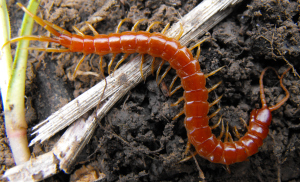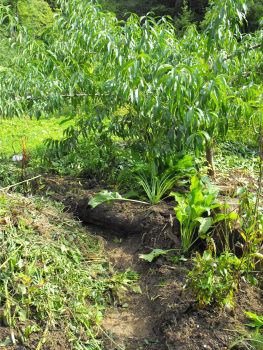
A forest garden island
 Remember my ambitious plans to construct
a forest garden between the baby fruit trees near the barn? I
planted a couple of beds, then the normal gardening season started and
the project got pushed onto the back burner.
Remember my ambitious plans to construct
a forest garden between the baby fruit trees near the barn? I
planted a couple of beds, then the normal gardening season started and
the project got pushed onto the back burner.
Since then, I've started a slightly less ambitious method of forest
gardening, one that fits in the scanty time gaps between vegetable
gardening. Instead of trying to create an entire forest garden in
one step, I've been creating "forest islands" by slowly extending the
raised beds around each tree. Whenever I pull weeds and don't
have anything better to do with them, I'll dump a wheelbarrow load
against the side of a tree's raised bed. A few weeks later, the
weeds have rotted down into rich soil.
 My oldest peach tree has been receiving this
treatment (albeit in a more willy-nilly fashion) for nearly three years
now. Wednesday, I pulled out another mass of weeds and poked
around at the humps of soil which now expand out in two directions from
the raised bed. White threads of fungi, a startled toad, and a
brilliant centipede all turned up --- signs that my little ecosystem is
healthy.
My oldest peach tree has been receiving this
treatment (albeit in a more willy-nilly fashion) for nearly three years
now. Wednesday, I pulled out another mass of weeds and poked
around at the humps of soil which now expand out in two directions from
the raised bed. White threads of fungi, a startled toad, and a
brilliant centipede all turned up --- signs that my little ecosystem is
healthy.
A little judicious shoveling and transplanting later and I've created a
forest island there. I planted comfrey and bee balm under the
peach's canopy, and fennel, echinacea, rhubarb, and Egyptian onions
further out from the trunk. My primary goal with these plantings
is weed control, with a secondary goal of strengthening the soil using dynamic
accumulators, and a tertiary goal of feeding hummingbirds and
parasitic wasps. Of course, I also chose the plants because I
have masses of them that need to come out of other parts of the
garden. I'm excited to see how this new forest garden island will
take hold!
Shame-faced plug: Create your own unique chicken waterer with our DIY
instructions.
Want more in-depth information? Browse through our books.
Or explore more posts by date or by subject.
About us: Anna Hess and Mark Hamilton spent over a decade living self-sufficiently in the mountains of Virginia before moving north to start over from scratch in the foothills of Ohio. They've experimented with permaculture, no-till gardening, trailersteading, home-based microbusinesses and much more, writing about their adventures in both blogs and books.
Want to be notified when new comments are posted on this page? Click on the RSS button after you add a comment to subscribe to the comment feed, or simply check the box beside "email replies to me" while writing your comment.
